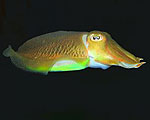Cuttlefish Ink Leads to Edible Batteries
 Dec-23-13
Researchers have used the pigments in cuttlefish ink to create edible, dissolvable batteries, which could provide a safe, biocompatible source of energy for implanted medical devices.
Dec-23-13
Researchers have used the pigments in cuttlefish ink to create edible, dissolvable batteries, which could provide a safe, biocompatible source of energy for implanted medical devices.Typically, batteries and the human body do not get along well, and the batteries of implanted medical devices must be protected by bulky cases. The prototype sodium-ion battery, created by a team from Carnegie Mellon University, was made by using manganese oxide as the cathode and melanin from cuttlefish ink as the anode. The materials used to make the battery will all break down safely in the body.
The team at CMU has been working to develop edible electronics and smart pills, and the bio-compatible batteries have brought them a step closer to realizing that goal.
More Info about this Invention:
[TECHNOLOGYREVIEW.COM][BETTINGER GROUP]

Add Your Comment